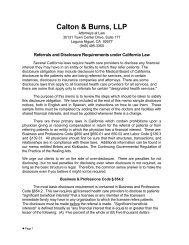Enhancing Your Practice's Revenue - California Orthopaedic ...
Enhancing Your Practice's Revenue - California Orthopaedic ...
Enhancing Your Practice's Revenue - California Orthopaedic ...
- No tags were found...
You also want an ePaper? Increase the reach of your titles
YUMPU automatically turns print PDFs into web optimized ePapers that Google loves.
coverage on specified holidays. While this did not meetphysicians’ desire for a daily stipend, it at least providedsome recognition for covering call above and beyondthe routine basis.SummaryIn conclusion, payment for call coverage is the new realityand has become the norm across the nation. There areseveral important resources that have been identified above,which can help you benchmark what your practice canexpect in terms of payment amounts and methodology. Itis critically important to keep an open mind and an opendialogue as these negotiations evolve between the hospitaland the physicians. Sometimes a multi-pronged approachmay be the best possible outcome for all parties.Contact: Aleksandar Curcin, MD, MBA:acurcin@scoastortho.comChapter 8Physician-Hospital Joint VenturesBy Frederick N. Meyer, MDOverviewJoint ventures (JVs) between physicians and hospitals cantake many forms, including not just ASCs (See Chapter5: Ambulatory Surgery Centers), but also independentdiagnostic testing facilities (IDTFs), specialty centers(e.g., hand, shoulder, etc.), a satellite UCC, and soforth. Physicians and hospitals may also invest jointly inequipment leasing and real estate ventures, although thoseare not the focus of this chapter. The typical “clinical”joint venture consists of an outpatient facility that offersthe technical component of health care services. Thesebusinesses typically offer services that generate a technicaland/or facility fee that is billed to payers. Physicians arecredentialed to perform services at the facility - - - butcredentialing is not necessarily limited to investors.JVs can present physicians with an opportunity to supplementpractice income and offset the negative financialimpact of decreasing reimbursement and increasing overhead.One of the biggest stumbling blocks to physicianhospitaljoint ventures (and this is the case regardless ofwhat the business is) is the traditional lack of trust that mayexist between the parties. This must be overcome or theventure will not be successful. Further, there needs to be asharing of risk and reward that, even if this is not precisely“even,” is at least “acceptable” to the various stakeholders.Another stumbling block is the regulatory environment.Clinical JVs were once very common. Then, the Stark lawswere passed and enforcement of federal anti-kickback rulesbecame more rigorous; consequently, many clinical jointventures were sold off to third parties or discontinued.Recently, rules defining joint venture safe harbors and clarificationof the Office of Inspector General’s (OIG) positionon joint ventures have resulted in a renewed interest inthis business model. These safe harbors notwithstanding,Congress and the Centers for Medicare and Medicaid Services(CMS) have recently begun a major effort to restrictphysician-hospital joint ventures. Their basis for doing so isthat JVs have been identified as potential areas of fraud andabuse. Therefore all joint ventures need to be implementedwith sound legal advice. Bear in mind that in addition tothe federal Stark and anti-kickback laws, many states haveenacted their own statutes. See below.The “bottom line:” when designed and structured properly,physician-hospital JVs can improve patient care andphysicians’ net incomes. However, ventures that are designedand structured improperly can lead to poor financialresults, hard feelings between participants and disrepute inthe community.Advantages of Physician Hospital Joint Ventures• Advantages for the HospitalHospitals are often concerned that they will lose theirancillary revenues to competitive physician ventures. Itmay be better for hospitals to joint venture with physiciansand keep part of these revenues than do nothing andlose all of them. By partnering with physicians, hospitalsmay be able to share a substantial portion of the cost ofcapital expenditures with investing physicians. In addition,hospitals may be able to set conditions on the partnershipsuch as resolving concerns about “cherry-picking,” apractice whereby some physicians refer better paying, highmargin patients to their own facility while sending lowerpaying, lower margin patients to the hospital.Partnering with physicians can create new and improvedrelationships which can contribute to (a) inpatient and outpatientmarket expansion, enhanced working relationshipsbetween the hospital and physicians; (b) increased awarenessof physicians about cost management and efficiency;(c) increased physician loyalty; (d) a strong governance/organization structure; and (e) a coordinated approach toserving the needs of the community. All this can be a valuabletool for the hospital to recruit new physicians to thecommunity.Note: focusing specifically on ASCs for a moment, thefederal government has been regularly increasing reimbursementto Ambulatory Surgery Centers while decreasingreimbursement to hospital-based units. Third party payersare demanding greater efficiency and are showing a greaterwillingness to contract with freestanding ASCs for feesbelow those of the hospital. In addition, other competitorsincluding hospital and health care conglomerates arebuying ASC companies and developing ASCs to grow their28© 2011 American Academy of <strong>Orthopaedic</strong> Surgeons
















